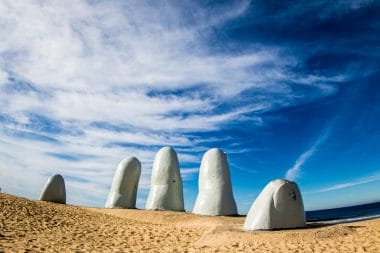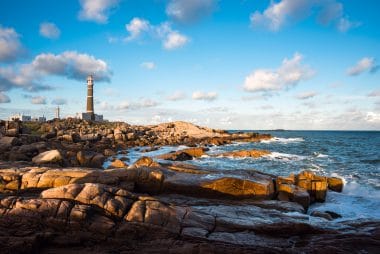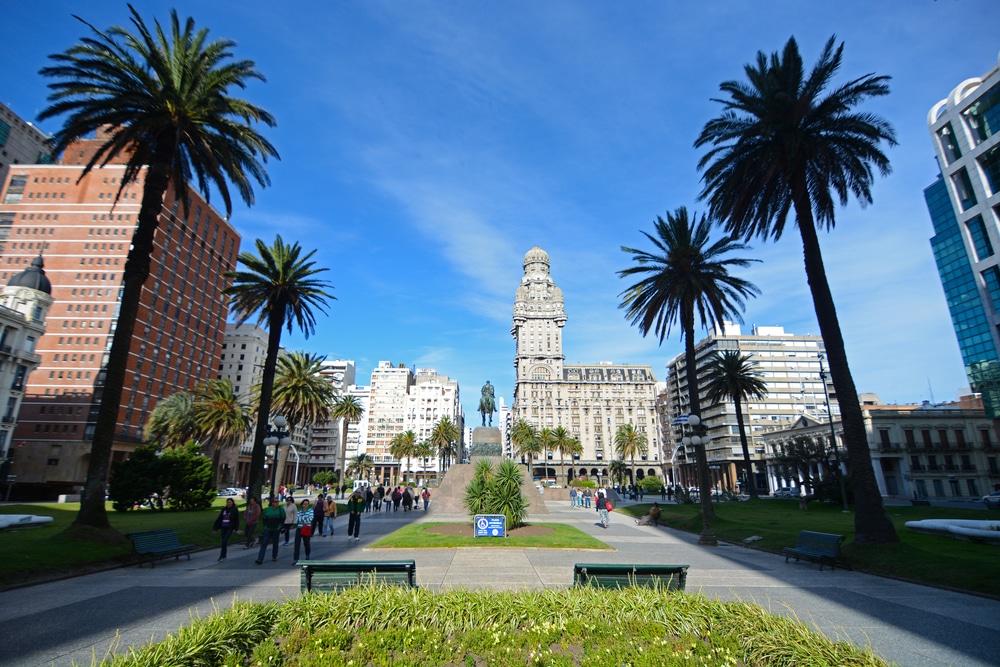A house with a garden – that’s how the locals affectionately call their beautiful country of Uruguay. They are alluding to the capital Montevideo , which lies like an elegant house in a garden in the middle of the seemingly endless green expanse of the pampas. The country in southern Latin America is always worth a trip.
Some facts about Uruguay
With an area of about 175,000 square kilometers, Uruguay is only about half the size of Germany. This makes it the smallest Spanish-speaking country in South America. Only about 3.2 million inhabitants live in Uruguay. That is fewer than in Berlin. By these standards, Montevideo, with its 1.5 million inhabitants, is a real capital, where half of the country’s entire population lives. Apart from Montevideo, there are only smaller cities in Uruguay with a few thousand inhabitants. The land is mostly flat and green.
There are no larger mountains, only hills with a little more than 500 meters in height. By Central European standards, the climate is mild and pleasant. It is similar to that in the south of France or northern Spain. There are no pronounced rainy or dry seasons. Since Uruguay is located in the southern hemisphere, the seasons are opposite to those in Germany. The hottest month is January with average temperatures around +22°C, the coldest month is July with temperatures between +10 and +13°C. Frost occurs only rarely. On the Atlantic coast, the bathing season lasts from November to April.
Sights in Uruguay
The fact that Uruguay is a small country where there are no high mountains, dense rainforests or large deserts does not mean that it is boring there. Quite the opposite. Uruguay has a lot to offer visitors. In addition, in contrast to other South American countries, the distances between the sights are manageable and the country is safe and stable by regional standards.
Montevideo
Probably everyone who comes to Uruguay will pay at least a short visit to the capital Montevideo. Montevideo is located on the banks of the Rio de la Plata, opposite Buenos Aires, but unlike the Argentine capital, it is manageable. The city is attractive and full of charm, especially due to the many historic buildings such as churches, palaces and museums. There are many squares and green spaces.
Among the historic buildings is the Teatro Solis, the second largest theater in South America. Even bathers get their money’s worth, because there are 2 city beaches on the Rio de la Plata. At large weekly markets you can buy all kinds of products, from antiques to meat or sausage fresh from the grill. The nightlife in Montevideo pulsates mainly in the old town. There are countless dance halls, bars and discos. However, operations do not really start until after midnight.
Punta del Este

The seaside resort is an ideal destination for those who love water sports and swimming. Punta del Este is located on the Atlantic coast, right at the mouth of the Rio de la Plata. There are rocky beach sections with rough seas as well as quiet bays that are suitable for families. You can make excursions in the surrounding area or watch seals on offshore islands or practice water sports.
Colonia del Sacramento
The historic town is located on the banks of the Rio de la Plata. Many buildings have been preserved from the Spanish colonial era. The lighthouse and the old city gate evoke memories of times long past. You can take a walk along the waterfront, relax and let the fresh breeze cool you down and admire the beautiful old town along the way. In Colonia del Sacramento there are many good restaurants with excellent cuisine.
Estancias (farms) at Mercedes and Tucuarembó
The South American version of “Farm Holidays” is offered there. The stay is something for nature lovers. The offer includes hiking, horseback riding, kayaking, swimming and simply a lot of peace and quiet. In many cases, there is full board because the visitors eat together with the host. The estancias are lonely and there are no hotels or restaurants far and wide.
Thermal springs at Salto
With a population of just over 100,000, Salto is the second largest city in Uruguay. There are hot springs where some thermal baths have been built. Salto is located on the Rio Uruguay and is a popular destination. The city is famous for its good weather and the quality of local wines.
The cuisine of Uruguay
Vegetarians have a hard time in Uruguay, because the locals love meat, especially beef, more than anything. There are hardly any meatless dishes. They prefer barbecues, favored by the good weather. Otherwise, influences from Spain and Italy prevail in the cuisine.
Big festivals in Uruguay

The most important festival is of course the carnival, which is celebrated extensively not only in Rio de Janeiro, but also in Montevideo. A typical local event is the “Semana Criollo” (Rodeo Week), which is held annually in April. There, the gauchos (South American cowboys) show their skills in riding and handling the cattle in front of an enthusiastic audience.
How to get to Uruguay?
Unfortunately, there is no direct flight connection from Germany . Montevideo can be reached by connecting flights via Madrid or Miami. However, there is an interesting alternative. You can book a flight to Buenos Aires and from there take the ferry across the Rio de la Plata to Montevideo. The ferries run every hour and the journey doesn’t take long. Up to a stay of 90 days, tourists do not need a visa to enter the country. Special vaccinations are also not required.


